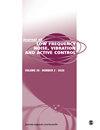悬索桥低频水下噪声辐射的声贡献
IF 2.4
4区 工程技术
Q1 ACOUSTICS
Journal of Low Frequency Noise Vibration and Active Control
Pub Date : 2023-07-20
DOI:10.1177/14613484231190460
引用次数: 0
摘要
对于跨河桥梁,车辆引起的振动可以传递到桥塔和基础系统。这种振动诱发的低频水下噪声辐射会对水生生物造成极大的危害。以某跨江悬索桥为研究对象,对水下噪声的声贡献和空间分布进行了研究。建立了桥梁-底泥耦合有限元模型,进行了车辆-桥梁-底泥耦合系统的动力响应分析。建立了声学有限元模型,对塔架和底泥的水下噪声进行了预测,并对两种声源的噪声贡献进行了比较。研究表明,桥塔和底泥辐射噪声在6.3 Hz以下,峰值频率在3.15 Hz左右。桥塔辐射噪声对桥塔附近总噪声水平的贡献大于沉积物,特别是水面附近。在其他空间中,泥沙振动产生的噪声占总噪声的主导地位。塔体辐射噪声具有侧向指向性,沉积物辐射的指向性与点声源相似。本文章由计算机程序翻译,如有差异,请以英文原文为准。
Sound contribution of the low frequency underwater noise radiated from a suspension bridge
For river crossing bridges, the vehicle-induced vibration can be transmitted to the bridge tower and foundation system. This vibration induced low frequency underwater noise radiation can cause great harm to aquatic organisms. A river crossing suspension bridge was selected to study the sound contribution and spatial distribution of the underwater noise. A bridge-sediment coupling finite element model was developed, and the vehicle-bridge-sediment interaction analysis was conducted to investigate the dynamic response of the coupling system. An acoustic finite element model was built to predict the underwater noise radiated from the tower and sediment, and the noise contribution of these two sound sources was compared. The research shows that the noise radiated from the bridge tower and the sediment is below 6.3 Hz, and the peak frequency is around 3.15 Hz. The noise radiated from bridge tower only has a larger contribution to the total noise level in its vicinity than the sediment, especially around the water surface. In other space, the noise generated through the sediment vibration plays a dominant role in the total noise. The radiated noise from the tower has lateral directivity, and the directivity of the sediment radiation is similar to the point sound source.
求助全文
通过发布文献求助,成功后即可免费获取论文全文。
去求助
来源期刊

Journal of Low Frequency Noise Vibration and Active Control
Engineering-Mechanical Engineering
CiteScore
4.90
自引率
4.30%
发文量
98
审稿时长
15 weeks
期刊介绍:
Journal of Low Frequency Noise, Vibration & Active Control is a peer-reviewed, open access journal, bringing together material which otherwise would be scattered. The journal is the cornerstone of the creation of a unified corpus of knowledge on the subject.
 求助内容:
求助内容: 应助结果提醒方式:
应助结果提醒方式:


